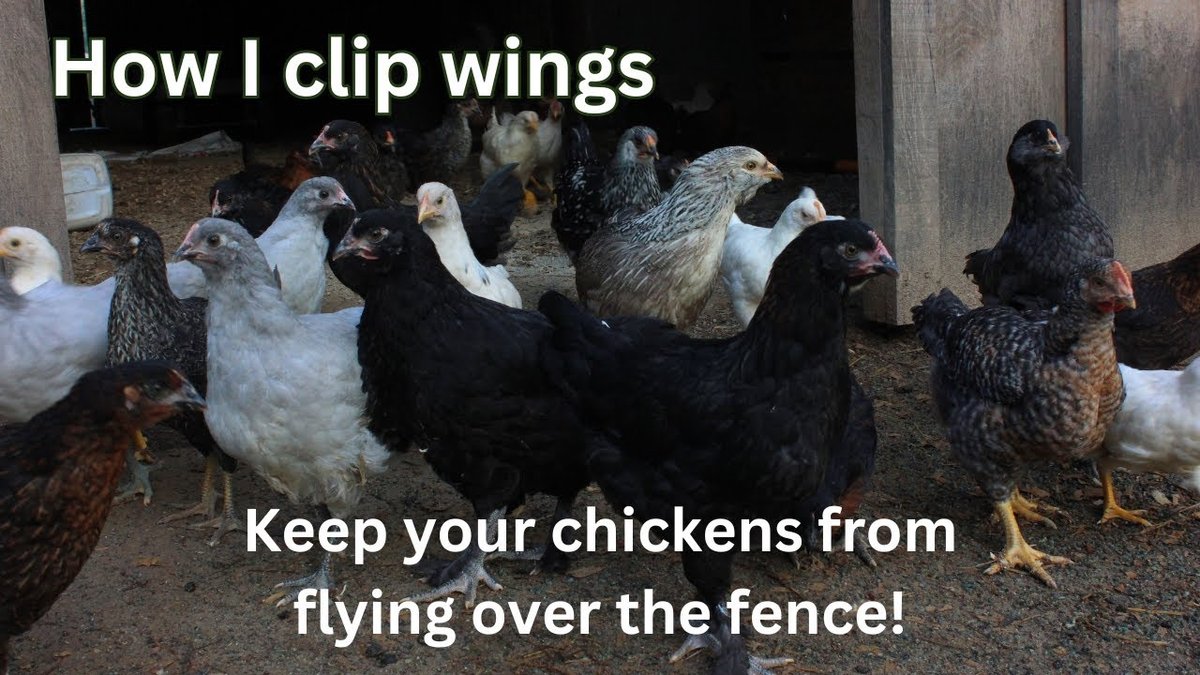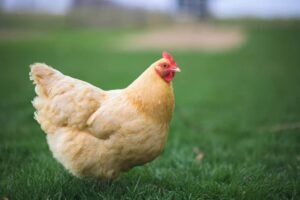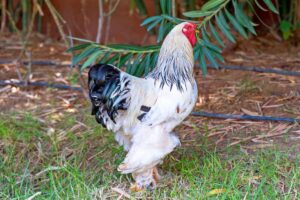It’s a common sight for backyard chicken keepers: a hen proudly perched on top of the fence, moments away from an unauthorized field trip. While it can be amusing, an escaping chicken is at risk from predators, traffic, and neighborhood pets. Keeping your flock safe and secure within their designated area is crucial for their well-being. This guide provides a deep dive into humane and effective methods to stop your chickens from flying over the fence, from simple coop adjustments to the step-by-step process of wing clipping.
Quick Answer: What Prevents Chickens from Flying Over Fences?
Chickens, the domesticated descendants of the junglefowl (Gallus gallus domesticus), aren’t long-distance flyers, but they are surprisingly good at short, powerful bursts of flight. Here are the most effective ways to keep them grounded:
- Increase Fence Height: A taller fence is often the simplest physical barrier.
- Modify the Fence Top: Adding unstable toppers or an overhang makes it difficult for chickens to find a secure landing spot.
- Remove “Launch Points”: Eliminating nearby objects like bins, woodpiles, or low-hanging branches that chickens use for a head start.
- Clip Their Wings: Humanely clipping the primary flight feathers on one wing creates a safe imbalance that disrupts their ability to gain lift.
- Use a roofed run. Hardware cloth is the most secure; bird or deer netting deters escapes and raptor swoops but isn’t raccoon‑proof.
Light breeds can clear 5–6 ft if motivated. Combine methods for best results: raise height or add an inward overhang, remove launch points, and consider a one‑wing clip after molt.
Can Chickens Fly Over Fences?
Yes, many chickens can fly over fences, especially lighter breeds. Their flight is typically a short, powerful burst to escape threats or explore, rather than sustained flight. A chicken’s flight is all about explosive, short-distance travel. While heavier breeds may struggle, many lighter, more athletic chicken breeds can clear a fence, especially if they are startled or have a running start from a perch or “launch point” (Source: Poultry Extension, University of Kentucky).
What Motivates a Chicken to Fly Out?
Understanding why your chicken wants to escape is key to stopping it. Common reasons include:
- Curiosity: The grass often looks greener on the other side.
- Foraging Instinct: They may see tasty bugs or plants just out of reach.
- Boredom: An uninteresting run can lead to escape attempts for simple entertainment.
- Fear: A predator or a sudden loud noise can cause a chicken to panic and fly over a barrier without thinking.
- Overcrowding: Not providing the space chickens really need can make them antsy and eager to find more room.
Factors Influencing Flight Ability
Not all chickens are equal when it comes to flight. Key factors include:
- Breed and Body Weight: This is the biggest factor. Lighter breeds like Leghorns have a body-weight-to-wing-size ratio that is much more favorable for flight than a heavy Brahma or Orpington.
- Age and Fitness: Young, fit pullets are often the most ambitious flyers in a flock. Older or heavier hens are typically more content to stay on the ground.
- Individual Personality: Some chickens are just more adventurous and prone to testing boundaries, regardless of breed.
Understanding that a motivated, lightweight chicken sees your fence as a minor obstacle is the first step. Now, let’s explore practical, humane ways to change their perspective and keep them safely contained.
Can a Chicken Fly Over a 6-Foot Fence?
Yes, a motivated, lightweight chicken can clear a 6-foot fence, especially if it has a launch point like a coop roof or woodpile. Heavier breeds are far less likely to make it over, but a 6-foot fence is not a foolproof guarantee for athletic flyers. Combining a tall fence with other methods, like removing launch points or using unstable toppers, is the most effective strategy.
How to Keep Chickens from Flying Out of a Fence (Humane Methods)
Before you consider clipping wings, several highly effective, non-invasive methods can solve your problem. Combining two or more of these strategies is often the most effective approach.
Raise Fence Height or Add an Overhang
A standard 4-foot fence is rarely enough for flighty breeds. Raising the fence to at least 6 feet is a much better deterrent. For a truly escape-proof solution, add a 1- to 2-foot section of fencing or netting at the top that angles inward at a 45-degree angle. This creates an overhang that chickens can’t see past or navigate, effectively stopping their attempts.
Use Flexible or Unstable Tops
Chickens have a strong sense of self-preservation and will not jump to a spot that feels unsafe or wobbly. You can use this to your advantage:
- Poultry Netting: String a line of loose, floppy poultry netting along the top of your fence. When a chicken tries to land, the instability will spook them, and they’ll drop back down.
- Single Wire: Even a single strand of wire or string run a few inches above the top of the fence can be enough to prevent them from finding a comfortable landing spot; ensure visibility to avoid injuries and comply with local codes.
- Roller Bars: Some people adapt “coyote rollers” for chickens. These are free-spinning pipes installed at the top of a fence that make it impossible for an animal to get a foothold.
Remove Launch Points
Take a walk around your chicken run and look for anything that gives your flock an extra boost. Chickens often use a two-step process to escape: jump onto an object, then fly over the fence. Common launchpads include:
- Compost bins
- Stacked firewood or lumber
- Coop roofs
- Water barrels
- Low-hanging tree branches Move these items at least 4-5 feet away from the fenceline.
Consider Electric Poultry Netting
For daytime foraging in a larger area, electric poultry netting is an excellent choice. Not only does the mild shock provide a memorable deterrent, but its flexible nature means there’s no solid top rail for a chicken to land on, making escapes much less likely. It’s also easily movable, allowing you to rotate your flock to fresh pasture, similar to a mobile chicken tractor setup. See examples of Using portable electric netting to contain pastured layers (NC State Extension).
Important Cautions:
- Maintain a proper charge and keep vegetation off the netting to ensure effectiveness; follow local codes regarding electric fencing.
- Avoid use with very young chicks that can entangle; always supervise your flock when introducing them to electric netting.
- Keep grass trimmed so the fence doesn’t short; check local ordinances before use.
Being a Good Neighbor: Containment and Local Rules
Remember that keeping your flock contained isn’t just for their safety; it’s also about being a responsible neighbor. Escaped chickens can damage gardens and create nuisances. Many city and county ordinances and even chicken laws by state require poultry to be securely contained at all times.
Physical barriers are the most reliable solution for keeping chickens in. However, if those methods still aren’t cutting it for a particularly persistent escapee, the next step is to humanely limit their ability to fly.
How to Clip Chicken Wings to Prevent Flying (Step by Step)
Wing clipping is a humane and generally painless method to prevent flight by trimming the primary flight feathers on one wing. This creates a safe imbalance that stops the chicken from gaining lift, and it must be redone after each molt. If fence modifications aren’t enough, clipping the flight feathers on one wing is a common, generally painless when done correctly, and humane solution that has been used by poultry keepers for generations. For a detailed visual guide, see how to Clip the primary flight feathers on one wing (extension guide).
Is Wing Clipping Humane and Safe?
Yes, when done correctly, it is completely safe and generally painless. Clipping a chicken’s feathers is exactly like getting a haircut; the feathers are made of keratin, and there are no nerve endings in the part you cut. The goal is to safely unbalance their flight, not to ground them completely. The most important rule is to never clip “blood feathers.” These are new feathers that are still growing and have a blood supply flowing through the quill to nourish them. A clipped blood feather will bleed profusely and is very painful for the bird (Source: Poultry Extension, University of Kentucky).
Tools and Timing
All you need for the task is a short list of tools. Wing clipping is best done when the bird is calm and relaxed, perhaps in the evening as they are getting ready to roost.
- Tools needed: Sharp poultry shears, a towel, styptic powder/cornstarch (for emergencies), and good lighting.
You will need to repeat the process after each molt (usually once or twice a year) as the clipped feathers fall out and new ones grow in.
One-Wing Clip vs Both-Wing Clip
The standard and most effective method is to clip only one wing. This creates an imbalance that causes the chicken to fly in a lopsided, downward spiral. They simply can’t get the lift they need to go up and over anything. Clipping both wings can sometimes restore their sense of balance, allowing persistent flyers to adapt and learn to fly again, defeating the purpose (Source: Poultry Extension, University of Kentucky).
Step-by-Step with Safety Checks
- Prep and Inspect: Work with two people if possible, especially your first time. One person should hold the chicken securely but gently, tucking its head under an arm to keep it calm. Gently extend one wing and inspect the feathers in good light. Look for blood feathers, which have a dark purple or blue, waxy-looking quill. If you see any, wait a few weeks for the feathers to mature before clipping.
- Identify Feathers: Fan out the wing like a deck of cards. The long, stiff feathers at the outermost edge are the primary flight feathers (usually the first 10). These are the only ones you will cut. The shorter, softer feathers overlapping them are the secondary feathers.
- Clip Line: A good rule of thumb is to cut the primary feathers back to the same length as the secondary feathers. This ensures you are cutting well below the “quick” or blood supply. Cut the feathers in one clean snip.
- Aftercare: Gently return the chicken to its flock. It’s normal for them to be a bit clumsy on their first few jumps. Observe them to ensure the clip is effective and they haven’t been ostracized by the flock (which is very rare).
What to Do if a Feather Bleeds
Accidents happen. If you inadvertently clip a blood feather, act quickly. Apply styptic powder, cornstarch, or flour to the tip of the bleeding feather shaft and apply gentle pressure until it stops. Monitor the bird closely. If bleeding doesn’t stop, contact a vet.
Can Chickens Still Fly After Wings Are Clipped? How High Can They Jump?
After a proper one-wing clip, a chicken’s powerful, upward flight is gone. Their efforts will be limited to short, clumsy hops and fluttering. They can typically still jump high enough to get onto low roosts inside their coop, which is important for their comfort, but they should not be able to clear a tall fence.
Wing clipping is a safe and effective tool, but it’s not the only one. For those who prefer a less hands-on approach, there are several excellent alternatives to consider for your flock.
Alternatives to Clipping Chicken Wings
The most effective alternatives to wing clipping are physical barriers, like a fully covered run or a taller fence with unstable toppers. Enriching the chicken’s environment to reduce boredom can also prevent escape attempts. If you prefer not to clip wings for any reason, these are excellent, highly effective alternatives.
A Completely Covered Run
This is the most secure method for containing your flock and a key part of predator-proofing your coop. Covering the top of your run not only keeps your chickens in, but it also provides critical protection from predators.
- Hardware Cloth: Most predator-resistant roof; durable but heavier and costlier.
- Poultry or Deer Netting: Lightweight and affordable for preventing escapes and raptor swoops, but not resistant to raccoons or strong climbers. Use covered runs and deterrents; harming raptors is illegal. Building a roofed, predator-resistant run is the ultimate solution. For a comprehensive overview, see how to Build a fully enclosed, predator-resistant run (NC State Extension).
Enrich the Environment
A bored chicken is an escape artist. Make the run the most interesting place to be!
- Dust Baths: Provide a dedicated area for a dust bath with loose soil, sand, or wood ash for them to clean their feathers.
- Roosts and Perches: Install perches of different heights and sizes. A simple log or branch can provide hours of entertainment.
- Treat Dispensers: Hang a head of cabbage or use a treat ball to make them work for their snacks.
Supervised Free-Ranging
Deciding between free-range vs run time is a common question, but letting your flock out to roam in the late afternoon or early evening is a great compromise. As dusk approaches, their natural instinct is to seek the safety of their coop to roost for the night, which makes it easy to get chickens back in the coop at night.
Breed Selection
The easiest way to deal with flying is to choose breeds that prefer to stay on the ground.
Choosing the right methods for your setup is key. For many, the simplest long-term solution is to start with a flock that isn’t inclined to fly in the first place.
What Chicken Breeds Don’t (Usually) Fly?
While any chicken can fly if motivated, some are far less likely to. The concept is called “wing load”—a simple ratio of body weight to wing size. Heavier, dual-purpose breeds have a high wing load, meaning their bodies are simply too heavy for their wings to lift them effectively off the ground for more than a brief hop.
(Tendencies, not guarantees)
| Breed | Flight Likelihood | Temperament |
|---|---|---|
| Buff Orpingtons | Very Low | Calm, Gentle |
| Brahma chickens | Very Low | Docile, Friendly |
| Cochin chickens | Very Low | Very Calm, Motherly |
| Plymouth Rock | Low | Hardy, Friendly |
| Wyandotte | Low | Calm, Good Forager |
| Leghorn | Very High | Active, Flighty |
| Araucana | High | Alert, Active |
| Bantam Breeds | High to Very High | Varies, Energetic |
Choosing a heavy breed can solve the flying problem before it starts. But no matter the breed, keeping them contained is tied directly to keeping them healthy, especially from pests that thrive in messy environments.
Health and Welfare: How to Prevent Fly-Strike (Myiasis) in Chickens
Keeping chickens contained is also a critical health issue. A clean, managed environment helps to keep pests out of the coop and prevents pests like blowflies, which can cause a dangerous and often fatal condition called fly-strike (myiasis). For information on preventing contagious diseases like Avian Influenza (bird flu), please see our separate guide on chicken coop biosecurity.
What is Fly-Strike?
Fly-strike occurs when flies (particularly blowflies) are attracted to soiled feathers or open wounds. They lay their eggs, and when the eggs hatch, the maggots begin to feed on the chicken’s flesh. It is a veterinary emergency that requires immediate care (Source: The Merck Veterinary Manual).
The Link Between Escaping and Health Risks
When chickens escape their run, they can get into damp, dirty areas like compost piles or muddy patches where flies breed. This increases their risk of coming into contact with the pests that cause fly-strike.
Actionable Prevention Steps
- Keep it Clean: Remove manure and soiled bedding from the coop daily. A “deep litter” method can work but you must know how to keep the coop clean and dry.
- Regular Health Checks: A weekly chicken health check is essential. At least once a week, pick up each chicken and check the feathers around their vent (bottom) for any clumps of manure. Gently clean any soiling you find with warm water.
- Manage Moisture: Ensure the coop and run have good drainage and ventilation. Wet environments are breeding grounds for flies. To learn more, read about Flies of poultry: lifecycle and control (Merck Veterinary Manual).
- Use Fly Traps: Place fly traps specifically designed for agricultural use and learn how to repel flies around the coop. (Source: University of Maryland Extension)
Keeping your chickens healthy includes using only safe and humane management practices. This means avoiding dangerous and cruel methods sometimes found on the internet.
Safety Notes and What NOT to Do (Weights to Keep Chickens from Flying)
Never attach weights or any other device to a chicken’s wings or legs. This is cruel, inhumane, can cause serious injury and pain, and violates basic animal welfare standards.
- Avoid using tape, string, or zip ties to bind feathers. These can cut off circulation and lead to injury.
- Similarly, avoid practices like pinioning, which is a permanent surgical alteration that should only be performed by a vet in specific circumstances.
- Remember that birds of prey are federally protected. Raptors are protected—use non-lethal prevention (U.S. Fish & Wildlife Service). You must use deterrents like covered runs rather than harming them.
- Always use the reversible, humane methods described in this guide.
With the right knowledge, keeping your flock safe and sound is straightforward. Let’s answer a few final, common questions to make sure you have all the information you need.
FAQs
Why can’t my chicken fly?
This could be due to its breed (heavy-bodied chickens are poor flyers), a proper wing clip, damaged feathers, a health issue, or simply a lack of motivation. Very young or old birds may also be less able.
Why can’t wild chickens fly?
This is a bit of a misconception. The wild ancestor of domestic chickens, the Red Junglefowl, can fly short distances to escape predators and roost in trees. Domestication has bred chickens to be heavier and more docile, which has reduced their flying ability.
How high can chickens fly?
Light breeds can reach 6–10 feet high and cover short distances in a burst, especially with a launch point.
Can you make chickens not fly?
You cannot permanently remove their ability to fly, but you can effectively manage it with the humane methods above, such as creating a covered run or correctly clipping the feathers on one wing after each molt.
Can I train my chickens to not fly over the fence?
While chickens can be trained, training them to ignore their instinct to fly over a low barrier is unreliable and not recommended as a primary containment strategy. Physical barriers or wing clipping are far more effective.
Clipping chickens’ wings: how often?
You will need to re-clip the primary flight feathers on one wing after every molt, which typically happens once or twice a year as they regrow their feathers.
Conclusion: Creating a Safe and Happy Flock Environment
Keeping your chickens from flying over the fence comes down to a simple principle: make their home a safe, engaging, and secure place to be. There is no single magic bullet, but rather a combination of smart strategies. By choosing the right breed, providing an escape-proof enclosure, enriching their environment, and using humane methods like wing clipping when necessary, you can solve the problem for good.
A secure chicken is a happy and healthy chicken. Investing a little time in your flock’s containment is one of the best ways to ensure you can enjoy their antics for years to come, right where they belong—safely in your backyard.
Author, Sources, and Care Disclaimer
This article was written by a backyard chicken keeper with over a decade of experience in humane flock management. The methods described are based on standard poultry husbandry practices.
Sources:
- Poultry Extension, University of Kentucky
- University of Maryland Extension, “Common Poultry Diseases”
- The Merck Veterinary Manual
Disclaimer: Always prioritize the health and safety of your animals. If you are unsure about performing a wing clip or have concerns about a chicken’s health, please consult with a local veterinarian who has experience with poultry. This guide was last updated on October 1, 2025.

Oladepo Babatunde is the founder of ChickenStarter.com. He is a backyard chicken keeper and educator who specializes in helping beginners raise healthy flocks, particularly in warm climates. His expertise comes from years of hands-on experience building coops, treating common chicken ailments, and solving flock management issues. His own happy hens are a testament to his methods, laying 25-30 eggs weekly.



